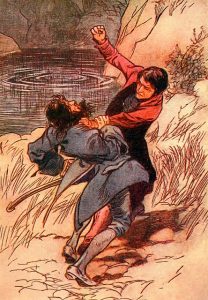Are you looking to craft a thrilling plot with an unexpected twist? The plot pyramid is the perfect tool to help elevate your story and bring it to life. From building tensions to introducing compelling characters, this blog post will show you how adding this plot structure to your thriller can add something special—and increase the suspense!
Introducing the plot pyramid
Elevating your thriller with the power of a plot pyramid is a great way to give your story an exciting and suspenseful edge. The plot pyramid, also known as Freytag’s Pyramid, is a diagram of five parts to illustrate dramatic structure.
The five-act structure of Freytag’s Pyramid
1. Exposition: This is the story’s beginning, where characters are introduced, and the main problem or conflict is established. Readers need to understand what’s happening and immediately get invested in the story. The exposition sets up questions about how things will turn out later on down the line.
To start, you should create a hook that captures readers’ attention—a teaser, if you will; something exciting or unexpected to draw them in. Then establish the inciting incident, which sets into motion events leading up to the central conflict or goal. This could be anything from discovering some hidden secret to finding someone who wants what they have.
2. Rising Action: After establishing its characters and situation, a narrative starts building momentum by introducing obstacles they face to reach their goal(s). These can range from minor tests of strength or intelligence to life-changing challenges that may endanger an entire world. Each sequence should create more tension than before till you finally reach your climax.
3. Climax: This is arguably one of – if not THE–most important parts of any story because it’s when all previous tensions come together with full ferocity for one grand battle where forces of good and evil are pitted against each other and only one side can win out in some way or another—either literally or metaphorically speaking.
At this point, readers should already know whether our heroes will triumph over adversity, but nothing can compare to seeing if they do! However heroic it may be, reaching this stage always holds some sorrowful consequence that leads us into…
4. Falling Action: Just after reaching its peak moment comes falling action—which sees our protagonists dealing with whatever consequences were brought upon them during their fight(s). Depending on how well they did, things might go more smoothly than expected (or worse), but there will still be quite a bit left unresolved until we get towards…
5. Resolution: Here, at last, our hero finally finds peace—often relinquishing their role as the protagonist while allowing others around them to take charge from now onward. Wrap it up with a resolution where characters learn their lessons, identify what was gained or lost throughout their journey thus far, find closure for any loose ends left hanging, etc.
Constructing this type of narrative framework makes organizing your overall plot easier. It allows room for smaller character arcs within each step and helps balance multiple elements, such as creative pacing and suspenseful beats while keeping readers hooked on every page!
Why follow a five-act structure rather than a three-act structure?

The five-act structure is recommended in a thriller because it allows writers and filmmakers to take advantage of the great suspense by building a story up slowly.
A three-act structure tends to be too quick, often leaving readers or viewers unsatisfied due to the lack of build-up. The five-act structure also gives writers more time for character development, essential to building suspense.
Here is an example of how this works:
In Alfred Hitchcock’s classic thriller Rear Window (1954), there are two key acts leading up to the climax: Act I introduces us to Jeffries (James Stewart), his broken leg, and the living room window; Act II follows his suspicions as he investigates what he has seen out his window each night.
This slow build-up keeps viewers engaged and wondering what will happen next until finally; we arrive at the grand finale in Acts IV and V—the climax where Jeffries catches Thorwald red-handed!
The nine distinct elements of a plot pyramid
A plot pyramid is an approach to outlining stories that explain their structure using nine distinct elements. The Setup or exposition of a thriller sets up the world, characters, and situation that will be explored throughout the story. Moving up through each tier of elements increases conflict and intensity until a resolution is reached.
Here’s a quick look at those levels:
The Setup is where you introduce the setting, characters, and other details needed to understand what’s happening in your story. It provides context for what’s about to come.
Conflict is where the plot begins as opposing forces or motivations arise, making it hard or seemingly impossible for things to work out in our protagonist’s favor.
Rising Action is all the events leading up to your climax because this is when tensions and stakes increase as anticipation builds toward an exciting conclusion!
The Climax is usually considered one of the most essential parts of your story, as it’s when everything reaches its peak intensity before beginning its descent toward resolution (or lack thereof).
The climax should be an exciting event with significant consequences hanging on the outcome, which keeps people engaged until they figure out how it all ends!
Massively High Stakes/ Crisis Point. You don’t necessarily need this component. Still, many stories benefit from introducing something extra right before release, which adds something extra special or unexpected to really “wow” readers with how high tension has become!
Resolution / Denouement is when all the tension finally releases at some point near the end, where we learn how things turn out for better or worse based on choices made throughout our journey!
Surprise Twist / Revelation. Sometimes stories benefit from having one more shocking moment (often near the very end), which leaves audiences guessing and keeps them wanting more even after they’ve already finished reading/watching/listening etc…
Moral Theme(s). Many writers also subtly imply some moral theme with their story so readers can reflect upon their experience upon completion, perhaps by highlighting how choices shape outcomes, etc…
Aftermath / Epilogue. Finally, some tales may also have an epilogue coming afterward, which serves both as closure and potentially hint at further adventures down roads not yet traveled… or perhaps never meant to be taken…
And there you have it—nine distinct elements used within a classic “plot pyramid” structure seen across so many beloved stories throughout time!
These nine plot steps can help you build a tight structure for your thriller without getting bogged down in unnecessary fluff or filler scenes. Be sure to raise stakes as much as possible so your readers feel invested enough to stick around until your thrilling conclusion! With this approach, you should have no problem elevating your narrative into something remarkable!
Creating tension with the first layer of the plot structure

Setting up the scene and introducing your characters
When crafting this layer of the story, paying attention to detail is essential to create an immersive experience for readers. Describe the setting in vivid detail, and include as much information about the characters as possible—their traits, motivations, fears, goals, and aspirations.
You can also use this layer of the pyramid to begin foreshadowing some important plot points that will occur later on. Introducing these hints throughout this layer helps build anticipation and make your story even more exciting.
Using obstacles to drive your story forward
Crafting engaging conflicts and turning points
The best way to ensure your story is exciting and engaging is to introduce obstacles your characters must overcome. Obstacles are the heart of a good thriller and should be structured thoughtfully throughout the rising action.
When introducing new obstacles, ensure they are relevant to your character arcs and the story arc. This will help ensure each twist builds up to the climax unexpectedly and keeps readers engaged.
It’s also important to consider turning points—moments that significantly alter your character’s trajectory. This will help increase reader engagement and ensure they stay invested in the story until the end.
Reaching the climax of your story

How a powerful climax can transform an average thriller into a gripping one
The climax of your story is one of the most essential parts, as it’s where everything comes together—and that means delivering an unforgettable experience to readers. A powerful climax should be unexpected yet inevitable—something they didn’t see coming but makes sense in hindsight.
Don’t be afraid to explore every possibility when crafting a climax for your thriller. Think about the characters, their arcs, and how they can reach a satisfying resolution. Consider introducing unexpected plot twists that surprise readers but remain faithful to the story and its themes.
The climax of your thriller should be intense, emotionally charged, and surprising. It should leave readers wondering what will happen next—or wanting more!
Building toward resolution
Wrapping up loose ends and giving readers a satisfying finale
Once you’ve reached the climax of your story, it’s time to bring everything together and get a resolution. This is where readers see how all the elements of the plot pyramid come together to produce an exciting conclusion that wraps up loose ends and delivers a satisfying ending.
When crafting this layer of your plot structure, consider what readers need to see to satisfy them. Consider the characters’ arcs and how they can be resolved while remaining true to their story. Also, consider any unanswered questions from earlier in the story—providing answers here will help create a sense of closure and leave readers feeling contented.
Crafting an unforgettable ending

Tips for creating an enjoyable final chapter that leaves readers wanting more
Your ending should be one that readers will remember, and it should come as a surprise but make sense in hindsight. To ensure this happens, think carefully about the tone of your story and how you want to convey the emotions behind the climax.
Make sure the ending offers closure – After all, this is the story’s last chapter—the reader needs to feel satisfied with how things ended. Give them a sense of finality and ensure all loose ends are tied off.
Make sure there’s still room for imagination – You don’t want the conclusion to be too cut-and-dry; instead, leave enough detail that readers will have plenty of questions left unanswered so their imaginations can wander when they’re done reading.
Surprise your readers – An unexpected twist or turn in the final chapter helps add narrative tension and keeps readers engaged until they reach your climax (or anti-climax). Introducing new elements at this point is also a great way to surprise your audience and leave them thinking about what could come next if there were another book in the series!
Create strong imagery & emotion – The images, sights, smells, feelings—all these details create vivid mental pictures for readers that impact how they’ll remember the story when they finish reading it. Use strong imagery to convey powerful emotions to heighten drama & build excitement toward the end of your novel or short story!
End on a note of optimism/hope – A positive outlook on life leaves people feeling inspired after closing out your work; wrap up with something uplifting so people will close out feeling complete instead of pensive or sad about saying goodbye after such an engaging journey together through words!
Conclusion
Whether your story is about small moments or life-changing events, the plot pyramid is an excellent tool for your writers’ toolbox. Everyone creates climaxes and resolutions differently—there’s no wrong way to do it regarding storytelling.
However, you need to have a sense of tension throughout each layer of the story structure for the reader to remain engaged until they reach the end. You want your readers to turn the pages, wanting to see what lies beyond each obstacle. What awaits them at the peak of the mountain?
Ensure that your final resolution offers closure for both characters and readers, leaving them with an overall sense of satisfaction!
Creating a great thriller requires careful planning and attention to detail. Follow these tips and create a thrilling story that will leave readers breathless! Good luck!
Thanks for taking the time to read. May you find success and joy in all that you create.
If you’re working on your first novel and are looking for more help with your writing, please check out my other articles at https://ullahakanson.com/blog/
Best of luck with your writing!
Ulla
www.ullahakanson.com

